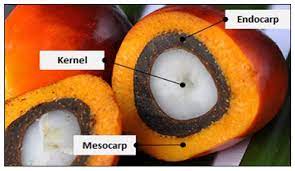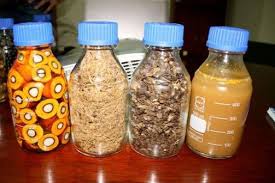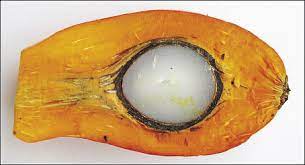Economic Importance, Uses, and By-Products of Oil Palm Mesocarp
Oil palm mesocarp refers to the fleshy, reddish-orange fruit flesh that surrounds the oil-rich kernel or seed in the oil palm tree (Elaeis guineensis). The oil palm is a tropical plant native to West Africa but is now extensively cultivated in various regions around the world, particularly in Southeast Asia, for its edible oil.
The mesocarp accounts for the bulk of the oil palm fruit and is the primary source of palm oil production. It constitutes approximately 45-55% of the whole fruit’s weight. The mesocarp is composed of a combination of oil, water, fiber, and other solids. Its texture is soft and juicy, making it easy to extract the oil contained within.
The oil palm mesocarp consists of numerous individual oil cells embedded in a fibrous matrix. These oil cells are responsible for storing the majority of the oil content. When the fruit ripens, the oil cells accumulate more oil, giving the mesocarp its characteristic oily nature.
To extract palm oil from the mesocarp, the fruits are typically harvested when they reach maturity and undergo a series of processing steps. After the fruits are sterilized and stripped of their outer layers, the mesocarp is separated from the kernel. It is then mechanically pressed or subjected to solvent extraction methods to obtain the crude palm oil.
Due to its high oil content and favorable oil composition, palm oil derived from the oil palm mesocarp is widely used in various industries, including food, cosmetics, and biofuel production. It is known for its stability at high temperatures, long shelf life, and versatile applications.
However, it is important to note that the expansion of oil palm plantations has raised concerns regarding deforestation, biodiversity loss, and environmental impacts in certain regions. Sustainable practices and efforts to mitigate these concerns are being implemented to ensure responsible palm oil production and minimize its negative effects.
Economic Importance, Uses, and By-Products of Oil Palm Mesocarp

Oil palm mesocarp refers to the fleshy pulp of the oil palm fruit, which surrounds the kernel or seed. The mesocarp is rich in oil content and is widely utilized in various industries due to its economic importance. Here are some of the key economic uses and applications of oil palm mesocarp:
1. Palm Oil Production: The primary economic use of oil palm mesocarp is for the production of palm oil. The mesocarp is processed to extract crude palm oil, which is one of the most widely consumed vegetable oils globally. Palm oil is used in various food products, such as cooking oil, margarine, snacks, and baked goods. It is also used in non-food applications like cosmetics, soaps, detergents, and biofuels.
2. Palm Kernel Oil Production: After extracting palm oil from the mesocarp, the palm kernel is separated and processed to obtain palm kernel oil. This oil has different properties compared to palm oil and finds applications in the food industry for products like chocolates, ice creams, and confectionery. It is also used in personal care products and as a raw material in the production of oleochemicals.
3. Animal Feed: The mesocarp, along with other oil palm by-products like palm kernel cake, can be used as animal feed. The mesocarp contains significant amounts of fiber and carbohydrates, providing energy for livestock. By-products like palm kernel cake are a good source of protein and are commonly used as feed for cattle, poultry, and other livestock.
4. Fertilizer: The mesocarp, in the form of empty fruit bunches (EFB), can be used as organic fertilizer. EFB compost is rich in nutrients, including nitrogen, phosphorus, and potassium, which are essential for plant growth. It helps improve soil fertility, water retention, and nutrient availability, making it beneficial for agricultural purposes.
5. Biogas and Bioenergy: Oil palm mesocarp can be utilized in biogas production through anaerobic digestion. The mesocarp waste, along with other palm oil mill effluents, is broken down by bacteria to produce biogas, which can be used for electricity generation or as a source of renewable energy. This process helps reduce greenhouse gas emissions and provides a sustainable energy source.
6. Organic Mulch: The mesocarp and other oil palm by-products, when shredded, can be used as organic mulch in agriculture. Mulching helps conserve soil moisture, suppress weed growth, regulate soil temperature, and improve soil structure. It is commonly employed in plantations to enhance crop productivity and reduce the need for synthetic herbicides.
7. Biodegradable Packaging Material: Research is being conducted to develop biodegradable packaging materials from oil palm mesocarp fibers. These fibers can be processed into bioplastics, reducing the dependence on non-biodegradable plastics and contributing to environmental sustainability.
Read Also : Economic Importance, Uses, and By-Products of Oil Palm Spikelet
8. Waste Water Treatment: The mesocarp waste can be used in wastewater treatment processes due to its high organic content. It acts as a substrate for microorganisms that help break down pollutants and purify the water. This application helps mitigate the environmental impact of oil palm mill effluents.
9. Cosmetics and Personal Care Products: Oil palm mesocarp oil is used in the production of cosmetics and personal care products such as lotions, creams, soaps, shampoos, and conditioners. It is valued for its moisturizing properties and ability to nourish the skin and hair.
10. Biochemicals and Oleochemicals: Oil palm mesocarp oil can be converted into various biochemicals and oleochemicals. These compounds serve as raw materials in the production of items like bio-based lubricants, surfactants, emulsifiers, solvents, and bio-based polymers. They are eco-friendly alternatives to petroleum-based chemicals.
11. Nutraceuticals and Dietary Supplements: The mesocarp oil contains a range of phytonutrients and antioxidants that are beneficial for health. It can be used in the production of nutraceuticals and dietary supplements, contributing to the wellness industry.
12. Soap and Detergent Production: Oil palm mesocarp oil is utilized in the manufacturing of soaps and detergents due to its cleansing properties. It helps to remove dirt and impurities effectively, making it a common ingredient in cleaning products.
13. Industrial Applications: The mesocarp fibers can be processed into materials for various industrial applications. For example, the fibers can be used as reinforcement in composite materials for automotive parts, construction materials, and furniture. They can also be utilized in paper and cardboard production.
14. Soil Erosion Control: The mesocarp fibers can be incorporated into erosion control measures such as erosion control blankets and mats. These products help stabilize soil and prevent erosion, especially on slopes or areas prone to erosion.
15. Biochar Production: Oil palm mesocarp fibers can be converted into biochar, a form of charcoal used as a soil amendment. Biochar helps improve soil fertility, water retention, and nutrient availability, promoting plant growth and productivity.
16. Medicinal Uses: Traditional medicine systems in some regions use oil palm mesocarp extracts for various medicinal purposes. It is believed to possess antimicrobial, anti-inflammatory, and wound-healing properties.
17. Biofuel Production: Oil palm mesocarp can be converted into biofuels, such as biodiesel and biogasoline. These renewable fuels can be used as an alternative to fossil fuels in transportation, reducing carbon emissions and dependence on non-renewable resources.
18. Soap Noodles: Oil palm mesocarp oil is processed into soap noodles, which are the main ingredient in the production of solid soaps. Soap noodles are widely used in the soap manufacturing industry for various personal care and cleaning products.
19. Candle Production: The mesocarp oil can be used as a raw material in candle production. It provides a source of renewable and sustainable wax for making candles.
20. Livelihood Support: The oil palm industry, including the production and utilization of oil palm mesocarp, supports millions of livelihoods worldwide. It creates employment opportunities, especially in palm oil-producing regions, and contributes to the economic development of local communities.
21. Economic Exports: Oil palm mesocarp, in the form of palm oil and palm kernel oil, is a significant export commodity for many countries. It generates foreign exchange earnings and contributes to the national economy through trade and export revenues.
22. Research and Development: Oil palm mesocarp continues to be a subject of research and development for exploring new applications and improving existing processes. Ongoing research aims to maximize the utilization of oil palm mesocarp and minimize waste, enhancing the economic viability and sustainability of the industry.
23. Carbon Sequestration: Oil palm trees, including their mesocarp, have the ability to sequester carbon dioxide from the atmosphere. The cultivation of oil palm plantations helps offset carbon emissions and contributes to climate change mitigation efforts.
24. Employment Opportunities: The oil palm industry, including the processing and utilization of oil palm mesocarp, creates employment opportunities across the value chain. From plantation workers to mill operators, technicians, researchers, and traders, the industry supports a diverse range of job roles.
It’s important to note that the economic importance of oil palm mesocarp should be balanced with environmental and social considerations. Sustainable practices, responsible land management, and adherence to certifications and standards are crucial for minimizing the negative impacts and ensuring the long-term viability of the industry.
The Products and By-products That Can Be Derived From Oil Palm Mesocarp

Oil Palm Mesocarp, also known as palm fruit pulp, is the fleshy part of the oil palm fruit that surrounds the palm kernel. It contains a significant amount of oil and can be processed to produce various products and by-products. Here are some of the key products and by-products derived from Oil Palm Mesocarp:
1. Crude Palm Oil (CPO): The primary product obtained from the oil palm mesocarp is Crude Palm Oil. It is extracted through a process called palm oil milling. The mesocarp is heated and pressed to release the oil, which is then further refined to produce edible palm oil for cooking, food processing, and other applications.
2. Palm Kernel: While the mesocarp surrounds the palm kernel, it can be separated during the milling process. The palm kernel has its own set of uses and can be further processed to produce various products.
3. Palm Kernel Oil (PKO): The palm kernel contains oil that is different from the oil found in the mesocarp. It is extracted through a separate process and is used in food processing, cosmetics, detergents, and other industries.
4. Palm Kernel Meal: After the oil is extracted from the palm kernel, the remaining solid residue is called palm kernel meal. It is a by-product used primarily as animal feed due to its high protein content.
Read Also : Economic Importance, Uses, and By-Products of Oil Palm Flowers
5. Palm Fiber: The mesocarp also contains fibrous material, which can be separated and utilized. Palm fiber can be used in the production of various products, including mattresses, erosion control blankets, mulch, and biomass fuel.
6. Palm Kernel Shell (PKS): The outer hard shell of the palm kernel is a by-product that has multiple applications. It can be used as a solid fuel for energy production, as a component in construction materials, or as a substrate for activated carbon production.
7. Palm Pressed Fiber (PPF): PPF is a by-product obtained during the palm oil extraction process. It consists of the pressed fibers from the oil palm mesocarp. PPF can be used for composting, animal bedding, and as a raw material for the production of biodegradable products.
8. Empty Fruit Bunch (EFB): EFB is another by-product derived from the oil palm mesocarp. It consists of the dried empty fruit bunches after the extraction of palm oil. EFB has applications in the production of compost, biofertilizers, animal feed, and as a raw material for biomass fuel and pulp and paper industries.
9. Palm Fatty Acid Distillate (PFAD): PFAD is a by-product obtained during the refining process of crude palm oil. It is rich in free fatty acids and can be further processed into soap noodles, fatty acids for industrial applications, and as a feedstock for biodiesel production.
10. Palm Wax: The mesocarp oil can be fractionated to obtain a higher melting point fraction, which is known as palm wax. Palm wax has applications in the production of candles, polishes, cosmetics, and food coatings.
11. Palm Biomass: The residues obtained from the processing of oil palm mesocarp, such as palm fiber, palm kernel shell, palm pressed fiber, and empty fruit bunches, collectively constitute palm biomass. Palm biomass can be used as a renewable energy source through combustion or gasification, providing heat and electricity for various applications.
12. Palm Wine/Vinegar: The sap obtained from tapping the oil palm trunk can be fermented to produce palm wine, a traditional alcoholic beverage. Palm wine can further undergo fermentation to produce palm vinegar, which is used in culinary applications.
13. Biogas: The organic waste from oil palm mesocarp and other palm processing by-products can be used for anaerobic digestion to produce biogas. Biogas is a renewable energy source that can be utilized for cooking, heating, and electricity generation.
14. Organic Fertilizers: The waste materials from oil palm mesocarp processing, such as palm fiber, palm kernel meal, palm pressed fiber, and empty fruit bunches, can be composted to produce organic fertilizers. These fertilizers are rich in nutrients and can be used to enhance soil fertility in agricultural practices.
15. Animal Feed Supplements: Certain by-products derived from oil palm mesocarp, such as palm kernel meal and palm pressed fiber, are used as feed supplements for livestock, providing a source of protein, fiber, and other essential nutrients.
It is important to note that the utilization and processing of these products and by-products vary across different regions and industries. The oil palm industry strives to optimize the value chain and minimize waste through sustainable practices and innovative technologies.
Read ALso : The Complete List of Indigenous Crops of Africa









